Bare facts on hair loss
By Kumudini Hettiarachchi
The crowning glory, that's how most of us see it. We trim it, we grow it, we tease it into curls, we iron it, and in the latest trend we gel it and we tint it in the most unimaginable colours.
"But too much hair in an unwanted place and too little hair in a wanted place is always a problem," smiles Consultant Dermatologist Dr. Jayamini Seneviratne, who heads the Skin Unit of the Lady Ridgeway Hospital for Children in Colombo.
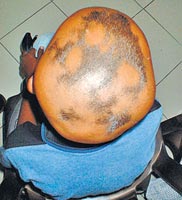 |
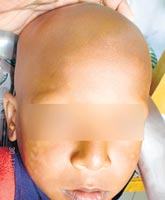 |
| Alopecia Areata |
Alopecia totalis |
Going back in time, he cites the changes between our hairy ancestors and modern man. "They were covered in hair, but gradually we have evolved into beings whose scalp hair plays a major role not only in our physical appearance but also on our mental wellbeing," he says.
And hair problems make men, women and children desperate, with people seeking immediate treatment. "Rest assured," reassures Dr. Seneviratne, "the problem is visible and one can easily arrive at the right diagnosis."
Hair diseases can be classified by the type of hair loss, depending on whether it is diffuse or patchy. Diffused loss of hair is often secondary to another cause which can be wide and varied as convalescence from a major illness, a viral infection, a psychological problem like stress due to an examination or even physical stress. "Most people may experience hair loss after dengue or chikungunya," he explains.
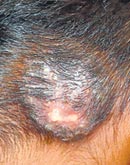 |
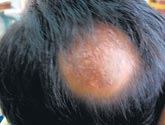 |
| Kerion |
Kerion after treatment |
Broadly, hair problems can be categorized into "inherited" or "acquired".
In the extreme situation, inherited problems could be due to a congenital absence of hair follicles. "This, however, is extremely rare," says Dr. Seneviratne.
Hair on the scalp grows about .3 - .4 mm/day or about 6 inches per year. Unlike other mammals, hair growth and loss is random and not seasonal or cyclic in humans. Each person's head has an average of 100,000 hair follicles. Each follicle can grow about 20 individual hairs in a person's lifetime, MediScene understands.
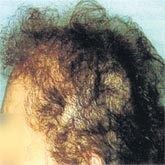 |
| Telogen Effluvium |
Did you know, asks Dr. Seneviratne, which creature other than a human has the longest anagen (growing) phase. "It's the horse," he answers, bringing to mind the "pony's tail".
Explaining hair loss which worries many people, he says there is "normal hair loss" and details the "hair-pull" test in which if you pull the scalp hair more than 10 should come off. This is known as a positive hair-pull test. Usually a person loses about 50-100 hairs a day.
MediScene learns that inherited hair problems could either be confined to hair or also associated with diseases that affect the skin, teeth and nails, while the more common hair diseases are acquired.
Here are a few causes of hair loss:
- Tinea Capitis (Ringworm of the scalp, fungal infection of the scalp) - This is an infection of the scalp by mould-like fungi called dermatophytes and is a skin disorder that exclusively affects children. It is very infectious to other children and may be passed on by direct contact or contaminated combs, hats and clothing. Transmission could also occur through contact with pets like dogs and cats that carry the infection.
Itching of the scalp, round scaly spots on the skin and scalp, redness and inflammation, bald patches and/or small black dots on the scalp are some of the symptoms. In extreme cases, pus filled lesions on the scalp may appear.
An aggravated form of Tinea Capitis is a kerion, an oozing inflammation of the scalp. It is the result of the patient's response to the fungal infection accompanied by a secondary bacterial infection. It is seen as raised, pus-filled and spongy lesions. Here the hair loss is permanent.
- Alopecia Areata - Characterized by hair-loss in the form of round patches of complete baldness, this may be due to a family history or an auto immune disorder and could also be associated with asthma or thyroid problems. It is commonly called Indigowwo kala and feared by people as a bad time etc. Under this category come Alopecia Totalis (complete loss of hair on the scalp) and Alopecia Universalis (complete loss of hair on the scalp and the entire body). The problem seems to go away on its own and those affected usually get back their hair in about one year.
- Traction Alopecia - This condition may occur when the hair is braided too tight or is damaged by a tight hair-styling method.
- Trichotillomania - This is a compulsive disorder by which hair on the head or face is twisted and/or pulled until it is damaged and breaks off leaving patches of uneven hair growth, thin hair areas or baldness.
- Telogen Effluvium (Stress-related hair loss, temporary hair loss) - In older children, especially after an illness, such hair loss could occur two months after, due to the normal hair growth cycle being interrupted with more hairs in a resting state then in a growing state. The problem corrects itself automatically in 3-6 months.
In adults, this is stress-related and therefore, temporary. Telogen is the name of the resting phase and this condition could be caused by high fever, childbirth, severe infections, chronic illness or psychological stress, major surgery, over or under active thyroid gland, crash diets with less protein and various medications.
During Telogen Effluvium more hairs go into the resting phase than the normal 10-15% and can increase to as much as 70%.
- Chemotherapy-related hair loss - Cancer does not cause hair loss but the medications used to fight cancer may cause total hair loss while some may experience a thinning of the hair. Generally, the hair will grow back once the chemotherapy treatment ceases.
The cycle |
It is interesting that under the 'hair growth cycle' there are three phases -
- Catagen, the transitional or 'in-between' phase - About 3% of all hairs are in this phase, which lasts about 2-3 weeks, at any given time. During this period, growth stops and the outer root sheath shrinks and attaches to the root of the hair, forming a 'club' hair.
- Anagen or the 'growing' phase - This is the active phase of the hair when the cells in the root of the hair divide rapidly. A new hair is formed and pushes the club hair up the follicle and out. During this phase the hair grows about 1 cm every 28 days. Scalp hair stays in this active phase of growth for 2-6 years. Some people have difficulty growing their hair because they have a short active phase of growth, while others with very long hair have a long active phase. The hair on the arms, legs, eyelashes and eyebrows have a very short active growth phase of about 30-45 days ensuring they are much shorter than scalp hair.
- Telogen, the 'resting' phase - This phase which accounts for 10-15% of all hairs lasts for about 100 days for those on the scalp and much longer for those on the eyebrow, eyelash, arm and leg. In this stage the hair follicle is at rest and the club hair is fully formed. Pulling out a hair at this time will reveal a solid, hard, dry, white material at the root. Normally, around 25-100 telogen hairs are shed each day.
|
|





